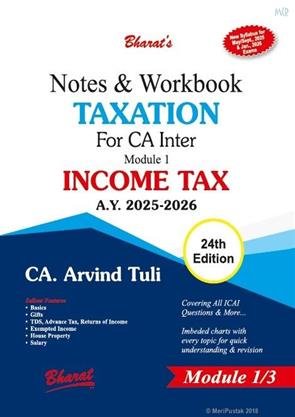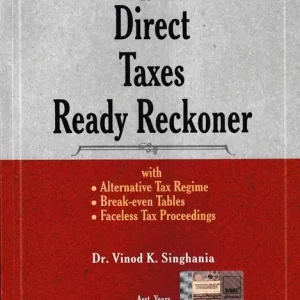Issues FAQs & Tax Planning Relating to Capital Gains by D.C. Agrawal, Sanjiv Dutt – 2nd Edition 2024
Original price was: ₹3,495.00.₹2,620.00Current price is: ₹2,620.00.
Issues FAQs & Tax Planning Relating to Capital Gains by D.C. Agrawal, Sanjiv Dutt – 2nd Edition 2024
Description
This book is a comprehensive treatise to understand the complexities of capital gains taxation under the Income-tax Act, 1961. Presented in an easy-to-follow question-and-answer format, the book addresses common queries encountered by taxpayers, professionals, and investors regarding the taxation of capital gains from various assets, such as immovable properties, equities, and mutual funds. The content spans 55 chapters, covering over 680 topics and approximately 1,200 issues, each supported by relevant case laws and practical examples. The book discusses the statutory provisions, exemptions, and intricacies of capital gains and incorporates the latest amendments from the Finance (No. 2) Act, 2024, making it a current and relevant resource.
This book will be helpful for departmental officers, taxpayers, litigants, and tax professionals to understand all the important and recurring issues that arise in capital gains.
The Present Publication is the 2nd Edition and has been amended by the Finance (No. 2) Act, 2024. This book is authored by D.C. Agrawal and Sanjiv Dutt, with the following noteworthy features:
- [Comprehensive Coverage] Spanning 55 chapters, the book covers over 680 topics and addresses approximately 1,200 questions related to capital gains taxation. It discusses the specific areas, including exemptions under Sections 54 to 54F, intricacies of Sections 45 to 55A, and provisions relevant to business trusts and international financial services
- [Practical Solutions and Case Laws] Each solution is backed by pertinent case laws, decided the Hon’ble Supreme Court, High Courts, and Income Tax Appellate Tribunal (ITAT). The book covers over 3,400 significant cases, ensuring that readers have access to a well-rounded understanding of how various statutory provisions have been interpreted and applied
- [Updated and Relevant Content] The Second Edition incorporates amendments made by the Finance (No. 2) Act, 2024, including changes in the capital gains tax rates, period of holding, withdrawal of indexation benefits, taxation of unlisted bonds or debentures, taxation of gifts by any person other than an individual or HUF
- [Simplification of Complex Topics] The book simplifies complex statutory provisions using a unique Q&A format, presenting them in a logical and systematic manner
- [Detailed Chapter Summaries and Tax Planning Checkpoints] Each chapter includes a summary and key tax planning points, enabling readers to quickly grasp and apply essential takeaways and apply them to their tax planning strategies
- [Special Focus Areas and Practical Applications] Dedicated chapters address unique scenarios such as capital gains taxation in IFSCs, under international taxation, and provisions for non-residents and offshore entities. The inclusion of real-life scenarios and practical examples illustrates the application of tax laws, making it easier for readers to relate the content to their specific situations
- [Case Law Digest] The book not only serves as a comprehensive guide but also functions as a digest, incorporating approximately 3,400 case laws, decided by the Hon’ble Supreme Court, High Courts, and Tribunals
- [Ease of Navigation] The book’s structure includes sub-topic headings and clear navigation paths, allowing readers to locate relevant information effortlessly. Each chapter’s logical flow, combined with minimal jargon and legalese, ensures that the content remains accessible and reader-friendly
- [Distinctive Approach and User-Friendly Structure] The book’s unconventional Q&A format stands out among traditional tax textbooks, providing an interactive learning experience that caters to various learning preferences. This distinctive approach helps in breaking down complex topics into easily digestible parts
The contents of the book are as follows:
- Chapter 1 – Introduction to Capital Gains
- Overview of key concepts, transactions not considered as transfers, computation methods, and exemptions under the Income-tax Act, 1961
- Chapter 2 – Exemptions Related to Capital Gains
- Detailed exploration of exemptions available under Section 10, including those for funds, institutions, specific tribes, and other entities
- Chapter 3 – Understanding Capital Assets
- Definitions and classifications of capital assets under Section 2(14), including real estate, intangible assets, and personal effects.
- Chapter 4 – Agricultural Land and Capital Gains
- Specific rules governing capital gains taxation on agricultural land, including compulsory acquisition and subsequent use
- Chapter 5 – Short-Term vs Long-Term Capital Gains
- Differentiation between short-term and long-term capital gains, including holding periods and special cases for various asset types
- Chapter 6 – Transfers and Non-Transfers
- Explanation of what constitutes a transfer under Section 2(47) and scenarios where transactions are not considered transfers
- Chapter 7 – Business Income vs Capital Gains
- Comparative analysis of income classified as business income versus capital gains, particularly in the context of asset sales
- Chapter 8 – Core Provisions of Capital Gains Taxation
- Comprehensive coverage of Section 45, including conditions for chargeability, exemptions, and special scenarios
- Chapters 9 to 11 – Capital Gains in Partnerships and Firm Reconstitution
- Sections dealing with capital gains arising from the entry of new partners, reconstitution of firms, and asset distributions
- Chapters 12 and 13 – Compulsory Acquisitions and Joint Development Agreements
- Specific provisions for capital gains arising from compulsory acquisitions (Section 45(5)) and joint development agreements (Section 45(5A))
- Chapters 14 and 15 – Liquidation and Buy-Back of Shares
- Tax implications of asset distributions during company liquidation (Section 46) and buy-back of shares (Section 46A)
- Chapters 16 and 17 – Non-Applicable Transfers and Withdrawal of Exemptions
- Transactions where capital gains provisions do not apply (Section 47) and conditions that trigger the withdrawal of exemptions (Section 47A)
- Chapters 18 and 19 – Computation Methods and Indexation
- Detailed methodologies for computing capital gains (Section 48) and applying indexation benefits for inflation adjustment
- Chapters 20 and 21 – Cost of Acquisition Rules
- Specific rules for determining the acquisition cost in various scenarios, including family settlements and special asset transfers.
- Chapters 22 to 27 – Special Provisions for Valuation and Consideration
- Sections dedicated to special cases such as market-linked debentures, slump sales, and valuation of unquoted shares or immovable properties
- Chapter 28 – Advance Money and Capital Asset Transfers
- Treatment of advance money received during transfers and its impact on capital gains (Section 51)
- Chapters 29 to 44 – Exemptions for Investments in Specific Assets
- Comprehensive guide to exemptions available under Sections 54 to 54H, including investments in residential properties, agricultural land, and specified funds
- Chapter 45 – Cost of Acquisition in Special Circumstances
- In-depth analysis of determining acquisition costs for various asset types as detailed in Section 55
- Chapter 46 – Valuation References and Procedures
- Guidelines for referring to valuation officers under Section 55A and the procedural aspects involved
- Chapter 47 – Set Off and Carry Forward of Losses
- Rules and strategies for setting off capital losses against gains and carrying forward losses to future years
- Chapter 48 – Taxation Rates for Capital Gains
- Applicable tax rates under Sections 111A, 112, and 112A explain applicable tax rates for short-term and long-term capital gains on various asset classes
- Chapter 49 – Capital Gains for Non-Residents and Offshore Entities
- Specific provisions addressing capital gains tax for non-residents, offshore funds, and FIIs under Sections 115AB, 115AC, 115ACA, and 115AD
- Chapter 50 – Alternative Tax Regimes for NRIs
- Special tax considerations and benefits for Non-Resident Indians as outlined in Sections 115C to 115-I
- Chapters 51 to 54 – Special Cases in Capital Gains Taxation
- Covers taxation on business trusts, transactions in IFSCs, international taxation, and other niche areas related to capital gains
- Chapter 55 – Frequently Asked Questions (FAQs)
- A comprehensive FAQ section addressing common queries, practical issues, and planning tips related to capital gains taxation
Additional information
| BINDING | PAPERBACK |
|---|---|
| AUTHOR | D.C. Agrawal, Sanjiv Dutt |
| EDITION | 2024 |
| ISBN | 9789356227347 |
| PUBLICATION | Taxmann |








Reviews
There are no reviews yet.